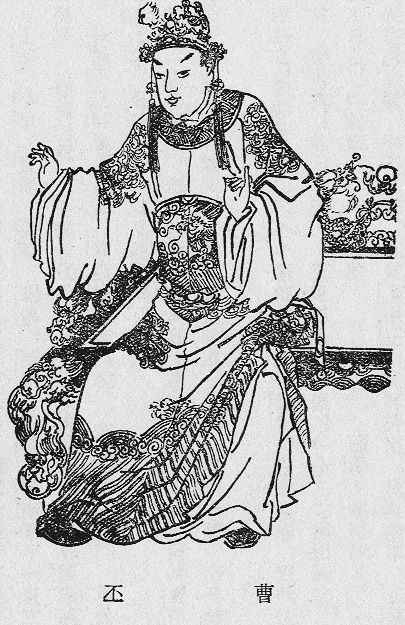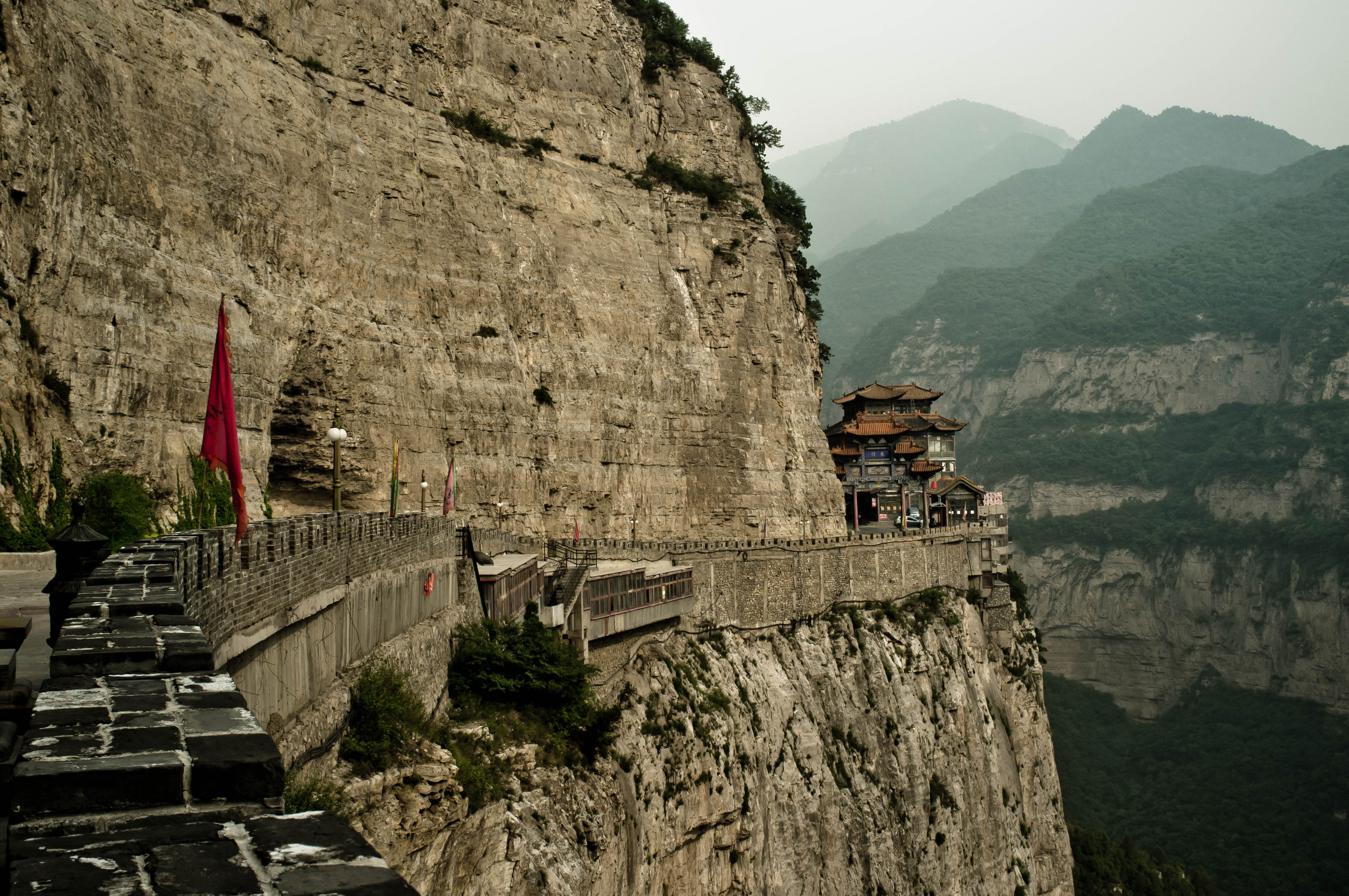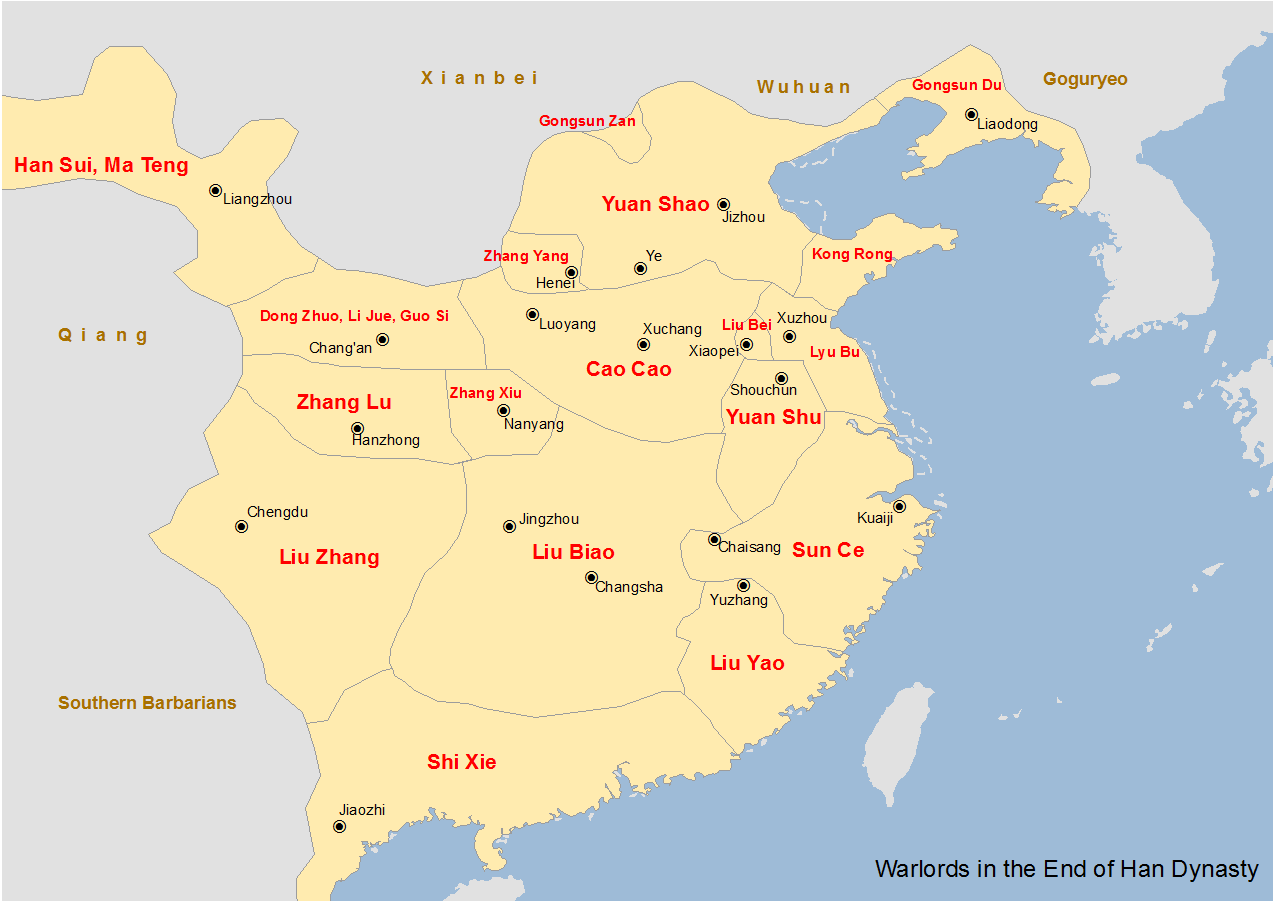|
Huan Jie
Huan Jie ( 190s–220s), courtesy name Boxu, was a Chinese official who lived during the late Eastern Han dynasty and served under the warlord Cao Cao. After the fall of the Eastern Han dynasty, he briefly served in the state of Cao Wei during the Three Kingdoms period. Family background Huan Jie was from Linxiang County (), Changsha Commandery (), which is present-day Linxiang, Hunan. His grandfather Huan Chao () and father Huan Sheng () both served as commandery administrators in the Eastern Han dynasty. Huan Sheng was also a Master of Writing () in the imperial secretariat and was famous in southern China. Early career Huan Jie started his career as an Officer of Merit () in Changsha Commandery, his home commandery. Sometime between 187 and 190, when Sun Jian was the Administrator () of Changsha Commandery, he nominated Huan Jie as a ''xiaolian'', so the Han central government summoned Huan Jie to the imperial capital, Luoyang, to serve as a Gentleman of Writing (). Whe ... [...More Info...] [...Related Items...] OR: [Wikipedia] [Google] [Baidu] |
Cao Pi
Cao Pi () ( – 29 June 226), courtesy name Zihuan, was the first emperor of the state of Cao Wei in the Three Kingdoms period of China. He was the second son of Cao Cao, a warlord who lived in the late Eastern Han dynasty, but the eldest son among all the children born to Cao Cao by his concubine (later wife), Lady Bian. According to some historical records, he was often in the presence of court officials in order to gain their support. He was mostly in charge of defence at the start of his career. After the defeat of Cao Cao's rival Yuan Shao at the Battle of Guandu, he took Yuan Xi's widow, Lady Zhen, as a concubine, but in 221 Lady Zhen died and Guo Nüwang became empress. On 25 November 220, Cao Pi forced Emperor Xian, the last ruler of the Eastern Han dynasty, to abdicate in his favour, after which on 11 December 220 he proclaimed himself emperor and established the state of Cao Wei. Cao Pi continued the wars against the states of Shu Han and Eastern Wu, founded by his ... [...More Info...] [...Related Items...] OR: [Wikipedia] [Google] [Baidu] |
Luoyang
Luoyang is a city located in the confluence area of Luo River (Henan), Luo River and Yellow River in the west of Henan province. Governed as a prefecture-level city, it borders the provincial capital of Zhengzhou to the east, Pingdingshan to the southeast, Nanyang, Henan, Nanyang to the south, Sanmenxia to the west, Jiyuan to the north, and Jiaozuo to the northeast. As of December 31, 2018, Luoyang had a population of 6,888,500 inhabitants with 2,751,400 people living in the built-up (or metro) area made of the city's five out of six urban districts (except the Jili District not continuously urbanized) and Yanshi District, now being conurbated. Situated on the Central Plain (China), central plain of China, Luoyang is among the List of oldest continuously inhabited cities#East Asia, oldest cities in China and one of the History of China#Ancient China, cradles of Chinese civilization. It is the earliest of the Historical capitals of China, Four Great Ancient Capitals of China. Name ... [...More Info...] [...Related Items...] OR: [Wikipedia] [Google] [Baidu] |
Duke Wen Of Jin
Duke Wen of Jin (697–628BC), born Chong'er (literally "Double Ears"), was a scion of the royal house of Jin during the Spring and Autumn Period of Chinese history. He famously endured a long period of exile from his realm before finally being restored to power (r.636–628BC) and rapidly leading Jin to hegemony over the other Chinese states of his time. He is a figure in numerous Chinese legends, including those about his loyal courtier Jie Zhitui, whose death is said to have inspired China's Cold Food and Qingming Festivals. Names "Duke Wen of Jin" is a posthumous name bestowed on him as part of his family's ancestral veneration. It literally means the "Cultured Duke of Jin". Duke Wen's given name was Chong'er. His clan name was Ji. Life Early life Prince Chong'er was born to Duke Xian of Jin in 697 BC. The '' Zuo Zhuan'' notes that "his ribs were all grown together," a sign of strength and leadership. Chong'er's half-brothers included Shensheng and Xiqi. While Shen ... [...More Info...] [...Related Items...] OR: [Wikipedia] [Google] [Baidu] |
Zhou Dynasty
The Zhou dynasty ( ; Old Chinese ( B&S): *''tiw'') was a royal dynasty of China that followed the Shang dynasty. Having lasted 789 years, the Zhou dynasty was the longest dynastic regime in Chinese history. The military control of China by the royal house, surnamed Ji, lasted initially from 1046 until 771 BC for a period known as the Western Zhou, and the political sphere of influence it created continued well into the Eastern Zhou period for another 500 years. The establishment date of 1046 BC is supported by the Xia–Shang–Zhou Chronology Project and David Pankenier, but David Nivison and Edward L. Shaughnessy date the establishment to 1045 BC. During the Zhou dynasty, centralized power decreased throughout the Spring and Autumn period until the Warring States period in the last two centuries of the dynasty. In the latter period, the Zhou court had little control over its constituent states that were at war with each other until the Qin state consolidated power and forme ... [...More Info...] [...Related Items...] OR: [Wikipedia] [Google] [Baidu] |
Duke Huan Of Qi
Duke Huan of Qi (; died 643 BC), personal name Xiǎobái (小白), was the ruler of the State of Qi from 685 to 643 BC. Living during the chaotic Spring and Autumn period, as the Zhou dynasty's former vassal states fought each other for supremacy, Duke Huan and his long-time advisor Guan Zhong managed to transform Qi into China's most powerful polity. Duke Huan was eventually recognized by most of the Zhou states as well as the Zhou royal family as Hegemon of China. In this position, he fought off invasions of China by non-Zhou peoples and attempted to restore order throughout the lands. Toward the end of his more than forty-year-long reign, however, Duke Huan's power began to decline as he grew ill and Qi came to be embroiled in factional strife. Following his death in 643 BC, Qi completely lost its predominance. Early life and rise to power Xiǎobái was born as one of Duke Xi of Qi's sons, though not in line of succession for the throne as he had at least two older brothers: ... [...More Info...] [...Related Items...] OR: [Wikipedia] [Google] [Baidu] |
Hunan
Hunan (, ; ) is a landlocked province of the People's Republic of China, part of the South Central China region. Located in the middle reaches of the Yangtze watershed, it borders the province-level divisions of Hubei to the north, Jiangxi to the east, Guangdong and Guangxi to the south, Guizhou to the west and Chongqing to the northwest. Its capital and largest city is Changsha, which also abuts the Xiang River. Hengyang, Zhuzhou, and Yueyang are among its most populous urban cities. With a population of just over 66 million residing in an area of approximately , it is China's 7th most populous province, the fourth most populous among landlocked provinces, the second most populous in South Central China after Guangdong and the most populous province in Central China. It is the largest province in South-Central China and the fourth largest among landlocked provinces and the 10th most extensive province by area. Hunan's nominal GDP was US$ 724 billion (CNY 4.6 trillion) a ... [...More Info...] [...Related Items...] OR: [Wikipedia] [Google] [Baidu] |
Hubei
Hubei (; ; alternately Hupeh) is a landlocked province of the People's Republic of China, and is part of the Central China region. The name of the province means "north of the lake", referring to its position north of Dongting Lake. The provincial capital, Wuhan, serves as a major transportation hub and the political, cultural, and economic hub of central China. Hubei's name is officially abbreviated to "" (), an ancient name associated with the eastern part of the province since the State of E of the Western Zhou dynasty of –771 BCE; a popular name for Hubei is "" () (suggested by that of the powerful State of Chu, which existed in the area during the Eastern Zhou dynasty of 770 – 256 BCE). Hubei borders the provinces of Henan to the north, Anhui to the east, Jiangxi to the southeast, Hunan to the south, Chongqing to the west, and Shaanxi to the northwest. The high-profile Three Gorges Dam is located at Yichang, in the west of the province. Hubei is the 7th-largest p ... [...More Info...] [...Related Items...] OR: [Wikipedia] [Google] [Baidu] |
Battle Of Guandu
The Battle of Guandu was fought between the warlords Cao Cao and Yuan Shao in 200 AD in the late Eastern Han dynasty. Cao Cao's decisive victory against Yuan Shao's numerically superior forces marked the turning point in their war. The victory was also the point at which Cao Cao became the dominant power in northern China, leading to the establishment of the state of Cao Wei in the Three Kingdoms period. Background The inevitability of military conflict between Cao Cao and Yuan Shao had become apparent by 196. Yuan Shao held control of the lands north of the Yellow River, namely the Hebei region, while Cao Cao controlled most of the lands south of the Yellow River after he defeated Lü Bu at the Battle of Xiapi in 199 and kept Emperor Xian with him in the new capital city of Xu. The warlords saw each other as the obvious impediment to their individual ambitions to conquer and rule China. Some years before the battle, Yuan Shao's advisors Ju Shou and Tian Feng warned that Ca ... [...More Info...] [...Related Items...] OR: [Wikipedia] [Google] [Baidu] |
Yuan Shao
Yuan Shao (, ; died 28 June 202), courtesy name Benchu (), was a Chinese military general, politician, and warlord who lived in the late Eastern Han dynasty. He occupied the northern territories of China during the civil wars that occurred towards the end of the Han dynasty. He was also an elder half-brother of Yuan Shu, a warlord who controlled the Huai River region, though the two were not on good terms with each other. One of the most powerful warlords of his time, Yuan Shao spearheaded a coalition of warlords against Dong Zhuo, who held Emperor Xian hostage in the imperial capital, Luoyang, but failed due to internal disunity. In 200, he launched a campaign against his rival Cao Cao but was defeated at the Battle of Guandu. He died of illness two years later in Ye. His eventual failure despite his illustrious family background and geographical advantages was commonly blamed on his indecisiveness and inability to heed the advice of his advisors. Family background Yua ... [...More Info...] [...Related Items...] OR: [Wikipedia] [Google] [Baidu] |
Danyang, Jiangsu
Danyang () is a county-level city located on the southwest (right) bank of the Yangtze River, and is under the administration of Zhenjiang, Jiangsu province, China. It is noted for the production of optical lenses used in sunglasses and eyeglasses. Danyang has a total area of and a population of roughly 890,000. Danyang locals speak a dialect of Wu Chinese, and the city is on the linguistic borderline between Wu Chinese and Jianghuai Mandarin. History During the period of the four Southern Dynasties (Nan Chao) from 420 to 589 A.D. when China's national capital was in Jiankang (modern Nanjing), Danyang was the hometown of the emperors of the Southern Qi (479-502) and Liang Dynasties (502-557), who were buried in the countryside outside the city. Today 11 of these Southern Dynasties imperial tombs can still be found to the east and northeast of the city. They are notable for their unique stone statues of mythical animals marking the sacred way (shen dao) leading to each imperial ... [...More Info...] [...Related Items...] OR: [Wikipedia] [Google] [Baidu] |
Xiangyang
Xiangyang is a prefecture-level city in northwestern Hubei province, China and the second largest city in Hubei by population. It was known as Xiangfan from 1950 to 2010. The Han River runs through Xiangyang's centre and divides the city north–south. The city itself is an agglomeration of two once separate cities: Fancheng and Xiangyang (or Xiangcheng), and was known as Xiangfan before 2010. What remains of old Xiangyang is located south of the Han River and contains one of the oldest still-intact city walls in China, while Fancheng is located to the north of the Han River. Both cities served prominent historical roles in both ancient and pre-modern Chinese history. Today, the city has been a target of government and private investment as the country seeks to urbanize and develop the interior provinces. Its built-up area made up of 3 urban districts had 2,319,640 inhabitants at the 2020 census while the whole municipality contained approximately 5,260,951 people. Histor ... [...More Info...] [...Related Items...] OR: [Wikipedia] [Google] [Baidu] |
Jing Province
Jingzhou or Jing Province was one of the Nine Provinces of ancient China referenced in Chinese historical texts such as the ''Tribute of Yu'', '' Erya'' and '' Rites of Zhou''. Jingzhou became an administrative division during the reign of Emperor Wu (r. 141–87 BCE) in the Western Han dynasty (206 BCE–9 CE). It usually corresponded with the modern-day provinces of Hubei and Hunan until the Sui dynasty, after which it referred to the city of Jingzhou. History Pre-Qin era In the Warring States period, the Chu state covered most of present-day Hubei and Hunan, the areas that would form Jingzhou in a later era. The Qin state dropped the name "Chu" (楚) (literally "chaste tree") and used its synonym "Jing" (荊) instead to avoid a naming taboo, since the personal name of Qin's King Zhuangxiang (281–247 BCE) was "Zichu" (子楚; lit. "son of Chu") because his adoptive mother, Lady Huayang, was from Chu. Chu was conquered by Qin in 223 BCE in the final stages of the Q ... [...More Info...] [...Related Items...] OR: [Wikipedia] [Google] [Baidu] |




.jpg)



